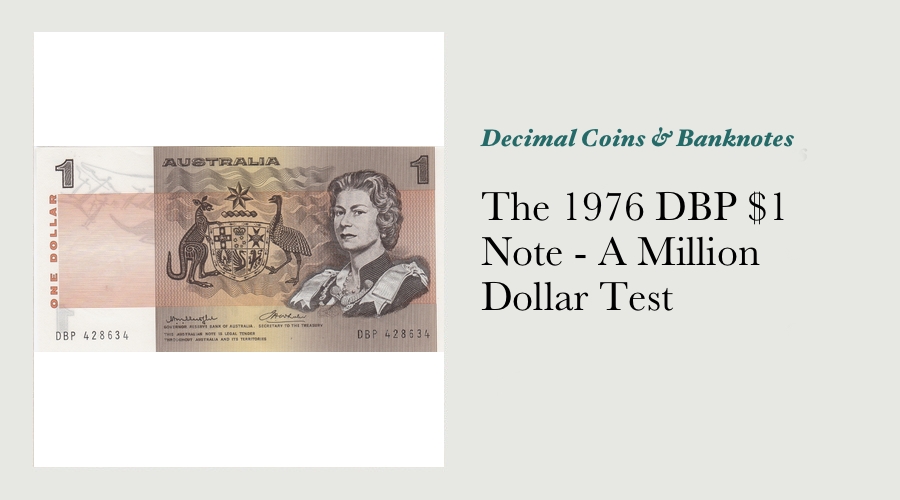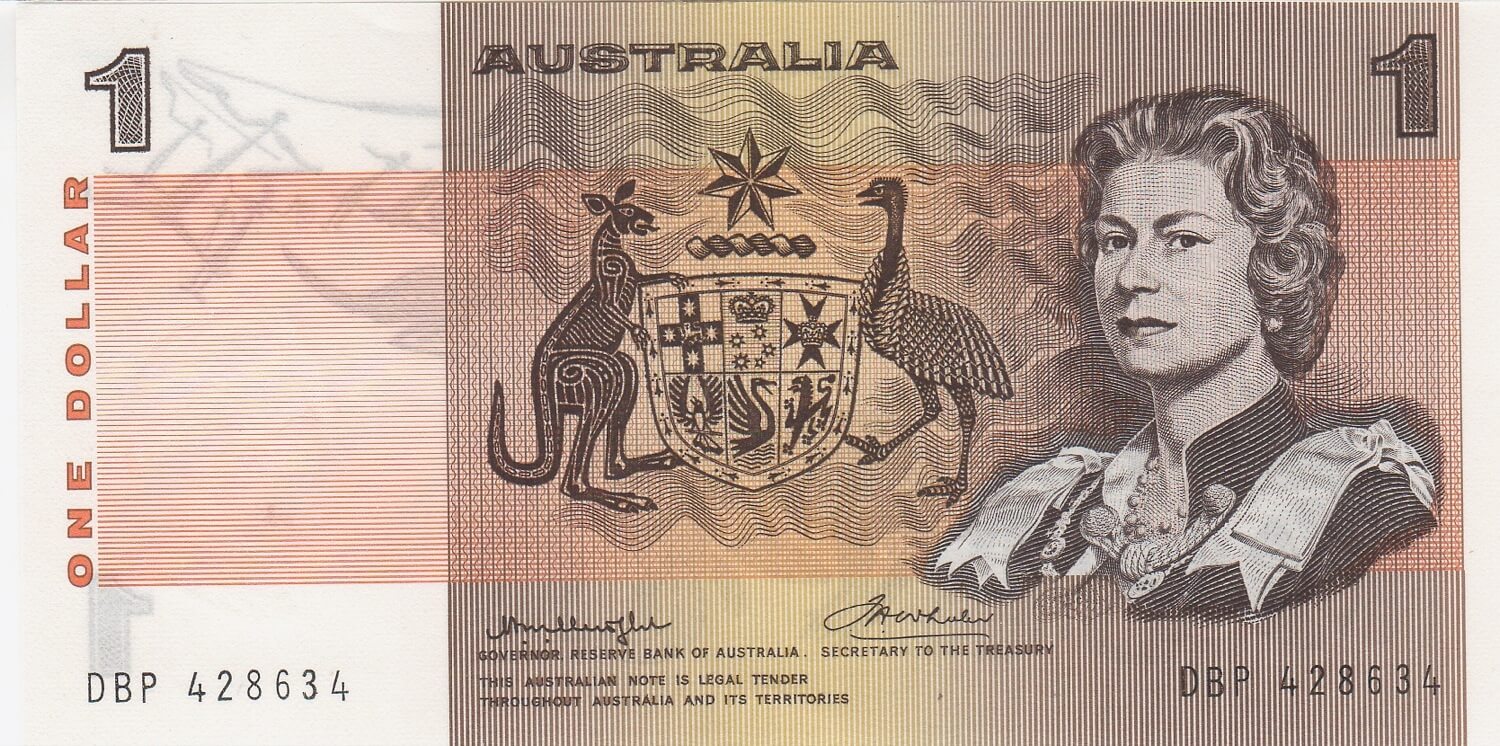The 1976 DBP $1 Note - A Million Dollar Test

The DBP $1 note is one that has been enthusiastically pursued by decimal note collectors for decades, although it's perhaps only in the past decade or so that collector interest has started to drive their value to a level that matches their historical appeal and rarity.
They are the first Australian notes to have been officially confirmed as being a very limited run of test notes, and they are the only Australian notes issued since Federation that have been proven to be directly related to several Australian cities - Perth, Brisbane and Hobart. The mintage of one million notes is exactly the same as the Coombs & Wilson first and last prefixes, and nearly as low as some star replacement notes - all of these notes are at present worth much, much more. 
The DBP $1 note is thought to have been first discovered late in 1977 by an eagle-eyed banknote collector in South Australia, and first brought to the wider attention of the banknote fraternity in an article written by the famed banknote collector Dr Alan Nicholson in the March 1981 edition of the Australian Coin Review Magazine.1
In his 1981 article, Dr Nicholson stated that “The DBP notes emerge as one of the more interesting sidelines of the decimal note series and will probably take their place in due course along with the star notes…”2 “It is almost certainly not the only time that the note issuing authorities have released an experimental printing but it is the only time so far that we are able to identify the notes concerned.3”
"Will Probably Take Their Place In Due Course Along With the Star Notes"
The DBP notes caught the eye of the South Australian collector because the letters in the serial numbers were significantly different to all of the other $1 notes that were being issued at that time.
The serial numbers of the new $1 notes entering circulation at that time "were all quite early in the 'C' series".
On the face of it, this doesn't sound like a big difference, however we have to keep in mind that each change in the first letter of a serial number indicates that 1 billion notes have been printed - one billion is certainly a huge difference!
Mick Vort-Ronald's Note Survey of 1981 showed that Knight Stone banknotes printed with a D serial prefix did not enter circulation until 1981 - some four years after the DBP notes were sighted in South Australia. Mick Vort Ronald wrote in 1982 that “I might also mention that one dollar notes with the serial letters DBJ are now in circulation in Melbourne with Knight Stone signatures, thus isolating the Knight Wheeler DBP notes – but that is something to be further speculated upon in another article."4
Although it might seem unusual that it took some time for collectors to discover this note, we have to remember that Note Printing Australia keeps information relating to the testing of Australia's currency notes as confidential as it can. Any information in the public domain about potentially scarce notes entering circulation could have had the potential to significantly alter circulation patterns and even "hoarding" rates, thus negating the very purpose of the test.
We can only presume that five years after the fact, Alan Nicholson had good connections at Note Printing Australia or the Reserve Bank of Australia, and they gave him an off the record explanation as to why and how the notes were issued.
Just 500,000 Notes Were Printed On Double-Fold Paper
The most detailed information that has come to light about the origin of the DBP test notes can be found in two letters to the editor of the Australian Coin Review Magazine in October 1988. Written by a former employee of Note Printing Australia and a representative of the Reserve Bank of Australia respectively, the first letter included the following information: "The cost of printing the $1 note was of concern to the bank given that some 80 million $1 notes were on issue at any one time and their life span was a mere seven months. As early as 1976 the Note Issue Department was considering options to cut the cost of printing some 100 million plus $1 notes each year. One consideration was the issue of a more durable note. Alternatively, consideration was being given to withdrawing the $1 note and replacing it with a $1 coin.
The exercise involving the issue of a more durable note called for Portals, who at that time supplied all of the banks printing paper, to provide a more durable paper. The paper currently in use was referred to as a "single fold" paper while the "new" test paper was referred to as a "double fold" paper. The "double fold" paper was of course a more costly paper.
One million notes with the DBP prefix were specially printed for the exercise, with the first 500,000 being printed on the "double fold" paper and the remainder i.e. from DBP 500,001 to DBP 999,999 being printed on the "single fold" paper.
Western Australia was chosen for the test area and stocks of both "double fold" and "single fold" notes were despatched to the branch of the Reserve Bank in Perth for issue to private banks in the area. As private banks requisitioned $1 notes, a mix of both "double fold" and "single fold" notes were supplied. In due course, as $1 notes filtered back into the Reserve Bank, the DBP notes were sorted, appropriately tagged and returned to the Note Printing Branch at Fitzroy for wear analysis.
Sadly the tests were to show that the durability of the "double fold" paper was only marginally better than the "single fold" paper and did not justify the additional expenditure arising from the use of the more costly paper. No further notes were printed on "double fold" paper.5"
Official Records Show They Were Tested Across 1977 and 1978, Not 1976
I find it interesting that the letter from a representative of the RBA, possibly the only authorised information published on the background to the status of the DBP test note stated that "over a 12-month period in 1977-78, the Bank conducted tests to evaluate whether a large batch of especially manufactured $1 notes, printed on a paper with a greater resistance to creasing, had a longer life in circulation than standard $1 notes.
These notes were issued mainly in Perth because of its relative isolation; a smaller number were issued in Brisbane. Notes in the test were printed with a unique prefix to facilitate subsequent out sorting. Although the test paper gave a very small increase in note life, the benefits were not large enough to justify general adoption of the special paper. As a result, no changes were made to the paper specified.6"
Although much of the information in that statement marries with that put forward by Dr Nicholson in his previous articles, Stuart states that the issue period was between 1977 and 1978 - significantly later than that which is accepted as gospel by collectors to date.
In his definitive book on Australia's Decimal Banknotes, Vort-Ronald states that "Of the DBP notes, 400,000 were sent to Brisbane and to Perth (hence DBP) and later, some to Hobart." He further states that "It may be that the test notes were from 500001 to 1000000, bearing in mind that notes were usually numbered backwards, from 999999 to 000001.7"
Again, this information is significantly different to that which is accepted as true by collectors today.
A mintage of just 500,000 notes really is quite tiny relative to others in the Australian paper decimal note series.
As Dr Alan Nicholson pointed out, on rarity alone the DBP test notes could well take their place alongside star notes and first prefixes in the years to come.
1 Dr Alan Nicholson; Australian Coin Review Magazine; Volume 17, Edition 9 (March 1981); Pages 41 & 42; "A decimal sideline".
2 Dr Alan Nicholson; Australian Coin Review Magazine; Volume 17, Edition 9 (March 1981); Pages 41 & 42; "A decimal sideline". 3 Dr Alan Nicholson; Australian Coin Review Magazine; Volume 17, Edition 9 (March 1981); Pages 41 & 42; "A decimal sideline".
4 Vort-Ronald, Mick; Australian Coin Review Magazine; Volume 18, Edition 7 (January 1982); Page 21; "1981 Note Survey".
5 R.C. (Epping); Australian Coin Review Magazine; Volume 25, Edition 12 (Issue 294; December 1988); Page 38; "A New $1 Note Variety".
6 R.C.Stuart, For the Secretary, Reserve Bank of Australia; Australian Coin Review Magazine; Volume 25, Edition 12 (Issue 294; December 1988); Page 38; "A New $1 Note Variety".
7 Vort-Ronald, Mick; "Australian Decimal Banknotes"; Self-published; 2000; Kadina; Second Edition; page 157.